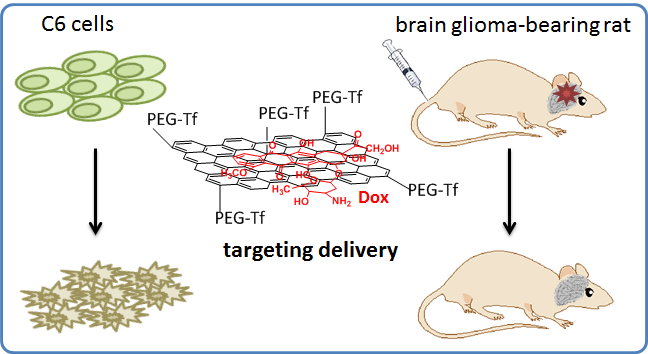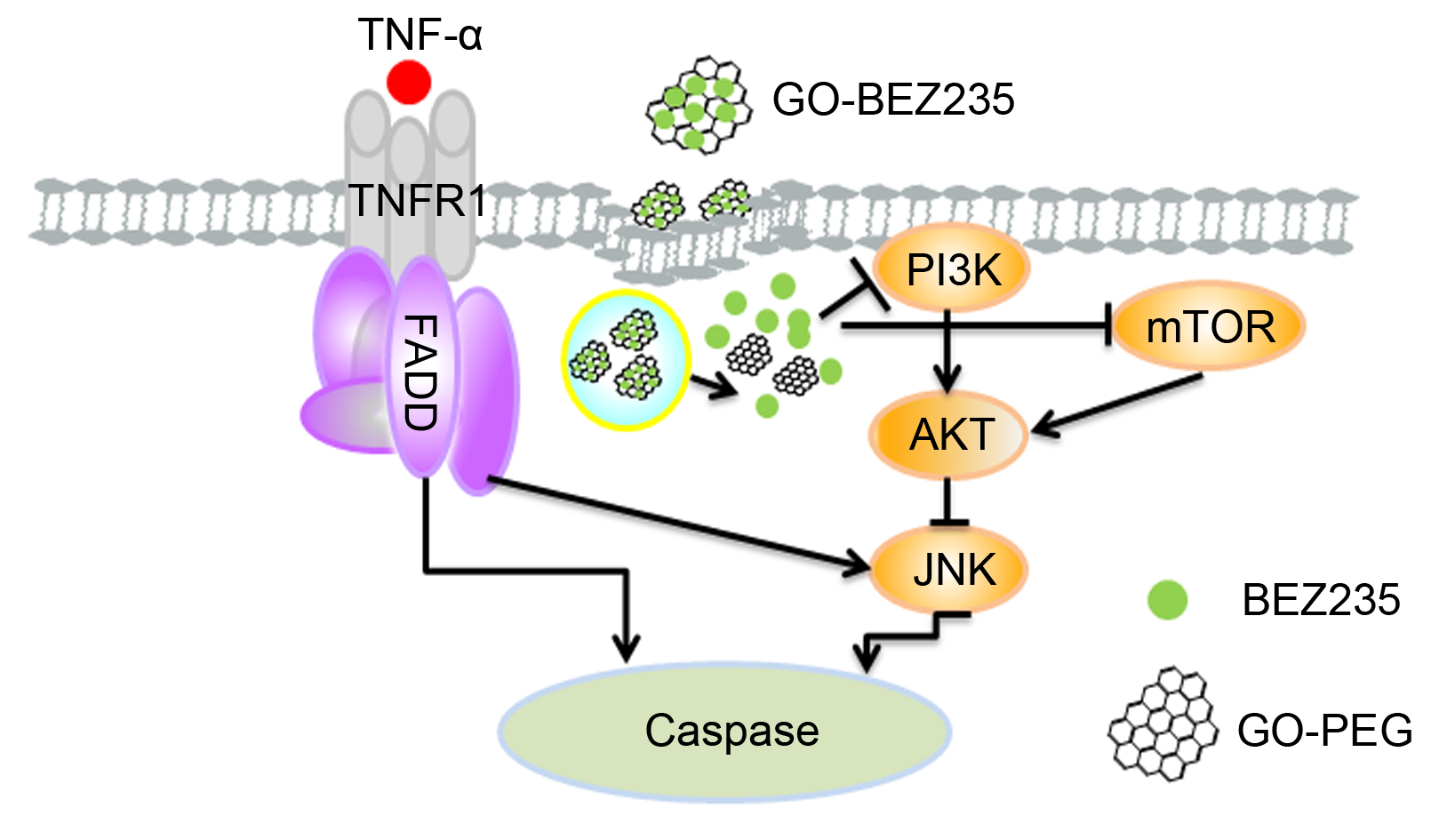Graphene exhibits unique 2-D structure and exceptional physical and chemical properties that lead to many potential applications. Among various biomedical applications, drug delivery systems based on graphene have attracted ever-increasing interests in the last few years.
Recently, a research team headed by Professor Zhijun Zhang at Suzhou Institute of Nano-Tech and Nano-Bionics, CAS, has made significant progress in development of graphene oxide (GO)-based drug delivery systems. They have demonstrated for the first time that PEGylated-GO as a biocompatible and efficient nanovector for loading and delivery of proteins into cells, and that GO prevents the proteins from enzymatic hydrolysis. Their work further indicates that the proteins delivered by PEG-GO retain their biological functions to regulate cell function (ACS Appl. Mater. Interfaces, 2012, 4, 6317-6323).
Based on the aforementioned work, Zhang group, in collaboration with Professor Qing Lan at the Second Affiliated Hospital, Soochow University, has explored the application of functional GO for glioma-targeted drug delivery. Transferrin (Tf), an iron-transporting serum glycoprotein that binds to receptors overexpressed at the surface of glioma cells, was chosen as the ligand to develop Tf-conjugated PEGylated GO for loading and glioma-targeted delivery of anticancer drug doxorubicin (Dox) (Tf-PEG-GO-Dox). Tf-PEG-GO-Dox displayed greater intracellular delivery efficiency and stronger cytotoxicity against C6 glioma cells. In vivo experiment further reveals that Tf-PEG-GO-Dox could deliver more Dox into the tumor site. As a result, the life span of the tumor bearing rats after the administration of Tf-PEG-GO-Dox was extended signi?cantly (Figure 1). Their work demonstrates that Tf-PEG-GO-Dox is a promising drug delivery system for glioma targeting chemotherapy (ACS Appl. Mater. Interfaces, 2013, 5, 6909-6914).

Figure 1. Diagram of Tf modified GO for glioma targeting delivery of anticancer drug.(Image by SINANO)
Combined drug treatment is widely used in clinical cancer therapy to overcome the drug resistance by cancer cells. Zhang’s group reported previously utilizing functional GO for controlled loading and targeted delivery of multiple drugs and gene (Small, 2010, 6, 537-544; Small, 2011, 7, 460-464). Recently, they explored the possibility of combined use of GO-loaded BEZ235 and TNF-α for PIK3CA mutant colorectal cancer cells therapy. The combination BEZ235 with TNF-α shows enhanced cellular proliferation inhibition for HCT 116 through enhancing G1 phase arrest and cell apoptosis, compared to either drug alone. Moreover, They reveals that the enhanced tumor cell apoptosis depends on activation of caspase-9, caspase-8 and caspase-3 mediated by the increased phosphorylation level of JNK (Figure 2) (Journal of Materials Chemistry B, 2013, DOI: 10.1039/C3TB20764A).

Figure 2. Proposed apoptotic pathway in HCT 116 cells treated by combination of graphene oxide-loaded BEZ235 and TNF-α.(Image by SINANO)
In addition, Zhang and colleagues, in collaboration with Professor Nongyue He at Southeast University, have developed a PEGylated reduced GO (RGO) nanovector for efficient delivery of ssRNA. Their work uncovers that RGO exhibits superior ssRNA loading and delivery capibility, compared to the widely studied GO. Computation simulation further suggests that PEG-RGO binds ssRNA much stronger than PEG-GO, in consistence with the experimental result. This work will have implications in designing RGO-based biocompatible and efficient ssRNA delivery systems. The work was published recently in J. Mater. Chem. B as cover article (Figure 3) (J. Mater. Chem. B, 2013, 1, 749-755).

Understanding the cellular uptake mechanism of GO and the release behavior of drug molecules from GO surface is very important for design of new efficient GO-based drug delivery systems. Working with Professor Bin Ren, Xiamen University, Zhang et al. studied the cellular uptake behavior of GO by means of surface enhanced Raman spectroscopy (SERS). They found that GO is internalized mainly through clathrin-mediated, energy-dependent endocytosis (Small, 2012, 8, 2577-2584). Most recently, they forwarded this work and developed composites of Ag nanoparticles and GO via covalent conjugation, and employed it to study the release behavior of anticancer drug Dox from GO carrier in living cells by SERS technique. They found that after cellular uptake of Dox and Ag nanoparticles-loaded-GO, Dox was released from GO inside the lysosomes, and then entered into the nucleus, while GO was trapped in the cytoplasm (Nanoscale, 2013, DOI: 10.1039/C3NR03264G).
Recently Zhang’s group summarized their work on GO-based drug delivery and bioimaging in an invited review “Biomedical Applications of Graphene” (Theranostics, 2012, 3(2), 283-294).
These researches were supported by the National Natural Science Foundation of China, Ministry of Science and Technology of China, Chinese Academy of Sciences, and Jiangsu Provincial Fund for Natural Sciences.

